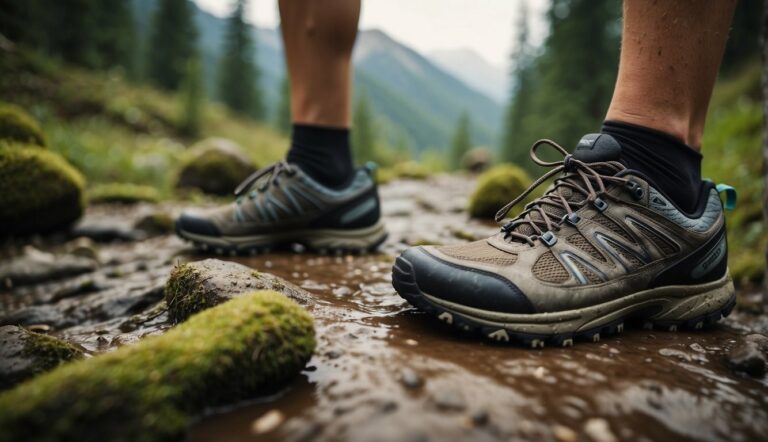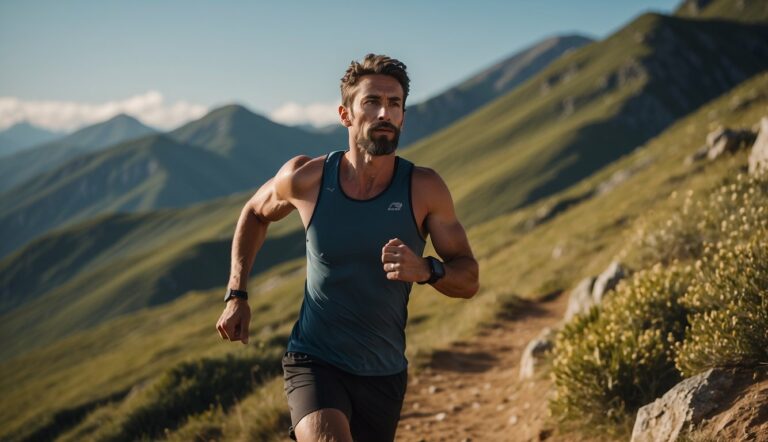Biomechanics of Trail Running: Unique Impacts on the Body Compared to Road Running
Trail running and road running are often lumped together as the same sport, but the demands they place on the body are quite different, with trail running presenting a unique set of biomechanical challenges. As a UESCA certified running coach, I’ve observed that the unpredictable and varied terrain of trails requires runners to engage more stabilizing muscles, adapt their gait, and exert different force patterns compared to the more consistent surfaces encountered in road running. This can lead to a different set of muscular adaptations and injury risks.
The biomechanics of trail running involves constant adjustments for inclines, trail obstacles, and varying surfaces. For example, studies indicate that when approaching a 10-12% grade, it becomes more efficient for a runner to switch from running to a power-hike. This is just one instance of how trail runners must use their bodies differently to maintain efficiency and safety on the trails. Trail runners also tend to have better agility and proprioception, which helps in navigating technical terrain that could otherwise lead to falls or injuries.
Comparatively, road running typically involves a more repetitive, steady motion on a flat surface, which has its own set of biomechanical efficiencies and injury profiles. While the cushioned, even terrain of roads can be less taxing on the body in some ways, it also can contribute to overuse injuries due to the repetitive nature of the running motion. Understanding these differences is key to improving performance and reducing the risk of injury in both trail and road running.
Fundamentals of Biomechanics in Running

In this exploration of running biomechanics, I’ll shed light on the mechanical aspects that differentiate trail and road running and address the principles of running economy crucial for runners’ performance.
Biomechanical Differences Between Trail and Road Running
Trail running and road running are distinct experiences primarily because of the varied surfaces encountered.
In trail running, the ground reaction force tends to be less predictable, with uneven terrain requiring greater leg stiffness and stability. This results in a diverse gait pattern, where the runner must frequently adjust stride length and stride frequency to navigate obstacles, compared to the consistent, flat surface of road running.
- Trail Running: Variable stride patterns, high demand for stability.
- Road Running: Uniform stride patterns, consistent kinetic demands.
On trails, the body’s biomechanics must adapt to uphill and downhill sections, requiring changes in energy expenditure and muscle activation (EMG). Posture also shifts to maintain balance, and trail runners thus develop a more robust proprioceptive sense to react to the demands of the terrain.
Key Principles of Running Economy
Running economy is the measure of how efficiently a runner uses energy at a given pace. A good running economy means lower energy consumption for the same distance. Here’s what affects it:
- Posture: Optimal alignment improves efficiency.
- Stride Parameters: Balanced stride length and frequency minimize effort.
The goal is to minimize excess movement, like vertical oscillation, which directs energy away from forward motion. I advise maintaining a compact arm swing and a slight forward lean to align with gravity, enhancing propulsion. Attention to spatiotemporal parameters helps maintain a rhythmic and energy-saving stride pattern.
To refine running economy, focus on:
- Streamlining posture: Keeping the body aligned reduces drag.
- Optimizing stride: A stride that’s too long can waste energy, while too short a stride may increase stride frequency unnecessarily.
Incorporating drills that promote kinetic efficiency, such as plyometrics, can improve leg stiffness and ground reaction force utilization, critical for both trail and road running but especially variable in trail scenarios due to terrain.
Physiological Responses to Trail Vs. Road Running
Trail running presents unique physiological challenges compared to road running, primarily due to varied terrain and elevation changes. These differences affect muscle activation, strength requirements, and cardiovascular demands.
Impact on Muscle Activation and Strength
When I transition from road to trail running, my body undergoes significant changes in muscle activation patterns.
The uneven surfaces of trails require a greater degree of balance and stability, causing increased engagement of stabilizer muscles in the lower legs. Strength in muscles, such as the quadriceps, hamstrings, and calves, becomes paramount to safely navigate the unpredictable terrain. Trail running can thus serve as a form of strength training, enhancing lower-limb muscle strength and improving overall technique.
- Primary Muscles Engaged on Trails vs Roads:
- Stabilizers: Ankles and knees require more support to maintain balance.
- Quads/Hamstrings: Engagement is heightened to manage uneven elevations.
- Calf Muscles: Essential for shock absorption on varied surfaces.
Heart Rate and Oxygen Uptake Variations
Comparing trail to road running, I notice that heart rate and oxygen uptake can be more variable on the trail due to constant changes in intensity.
The continuous adaptation to terrain requires my cardiovascular system to work harder, often leading to a higher average heart rate over the course of a trail run. Consequently, aerobic performance, including improvements in VO2max and lactate threshold, can be enhanced, contributing to better endurance running capability.
- Cardiovascular Response:
- Heart Rate: Generally higher average during trails due to terrain adaptability.
- Oxygen Uptake: Greater variability in response to shifting inclines and obstacles.
Trail Running Technique and Training

Trail running demands unique adaptations for varying terrains, requiring a strong blend of stability, strength, and endurance. Uphill and downhill sections each challenge the body in distinct ways, and targeted training can enhance performance and reduce injury risk.
Adaptations for Uphill and Downhill Running
When running uphill, I shift to a power-hike at gradients of 10-12% to maintain efficiency. The key here is to use strength training to bolster endurance performance for sustained climbs. Uphill running relies on increased hip and knee flexion to overcome gravity, emphasizing the need for targeted strength in the glutes and quadriceps.
On the contrary, downhill running necessitates control to minimize impact forces, which can otherwise lead to injuries such as ankle sprains. Here, training should focus on neuromotor control to enhance stability, and eccentric strength training to absorb the force impulse with each step. Proper cadence and knee flexion are also vital to reduce strain on the lower leg.
| Uphill Training Focus | Downhill Training Focus |
|---|---|
| Hip flexion strength | Neuromotor control |
| Knee flexion strength | Eccentric leg strength |
| Power-endurance | Joint stability |
Strategies for Improving Trail Running Performance
To improve trail running performance, I develop training protocols that simulate race conditions. This includes graded running to replicate the varied terrain encountered on trails. Training volume and intensity need to be carefully managed to avoid overtraining and to progressively build strength and endurance.
Furthermore, incorporating drills that enhance cadence and technique for both uphill and downhill sections are crucial for performance gains. Increasing the training load should be gradual and purposeful, with an eye on fostering running efficiency through all phases of the gait cycle.
| Training Component | Strategy for Improvement |
|---|---|
| Terrain Simulation | Graded running on diverse slopes |
| Endurance Building | Balanced increases in training volume |
| Technique Refinement | Drills specific to trail running dynamics |
| Load Progression | Gradual training loads to optimize adaptations |
Injury Risk and Prevention in Trail Running

Trail running presents unique challenges and injury risks not commonly found in road running. My expertise helps runners navigate these risks with effective preventative strategies and targeted strength exercises.
Common Trail Running Injuries and Causes
Trail running often involves variable terrain that can increase the risk of injury. Uneven ground and frequent elevation changes put additional stress on the body, particularly on the lower limbs. Here’s a breakdown of common injuries and their typical causes:
- Ankle sprains: Resulting from unstable surfaces and missteps.
- Knee injuries: Caused by increased joint angles and the impact of downhills.
- Muscle strains: Often due to the high demands of neuromuscular fatigue from prolonged stability engagement.
- Blisters and foot injuries: From the friction and shearing forces of varying terrains, especially in ultramarathons.
The hips and core play crucial roles in absorbing the high-impact forces encountered on trails. My experience shows that a lack of strength in these areas can lead to greater stiffness and potentially higher injury rates.
Preventative Strategies and Strength Exercises
Preventing injuries in trail running involves a multifaceted approach that combines proper technique with specific exercises. Here are key strategies to reduce the risk:
- Adjust Training Volume: Gradually increase training volume to allow the body time to adapt.
- Core Strengthening: Exercises like planks enhance core stability, crucial for trail running.
- Hip Activation: Movements such as side lunges improve hip strength, promoting better movement control.
- Downhill Technique: Practicing controlled descents helps minimize joint impact and perceived effort.
To maintain fitness and counteract the high cost of running on trails, I advocate for exercises that promote muscle engagement and reduce neuromuscular fatigue. Here’s a simple strength routine I recommend:
| Exercise | Sets | Reps | Purpose |
|---|---|---|---|
| Squats | 3 | 10-12 | Hips and core activation |
| Single-leg Deadlifts | 3 | 8-10 | Balance and stability |
| Lateral Band Walks | 3 | 10-15 | Hip muscle engagement |
| Mountain Climbers | 2 | 30s | Core stability and hip flexor activation |
Incorporating these strategies and exercises into a regular training routine can help trail runners manage injury risk and enjoy the sport safely.
Advanced Performance Metrics for Trail Runners
In trail running, advanced metrics go beyond basic parameters like distance and pace, factoring in unique trail characteristics that affect performance.
Utilization of Technology in Trail Running Analysis
I strongly recommend utilizing technology to analyze and improve trail running performance. Modern tools like global positioning systems (GPS) and accelerometers provide a wealth of data that I analyze to understand a trail runner’s performance in varying ecological conditions.
Key metrics such as velocity, stride length, flight time, and ground contact time can be captured. These indicators help me to determine the efficiency of a runner’s form and technique, especially over different types of running surfaces and elevation changes.
For assessing distance and pace, GPS watches are quite accurate and ideal for maintaining both during training and competitions.
- Technology used in analysis:
- GPS: Distance, pace, elevation
- Accelerometers: Stride length, ground contact time
- Wearable Sensors: Flight time, velocity
Agility and running form are also assessed through these technologies, which can be especially helpful in trail running due to the uneven and varied terrain encountered.
Assessing Running Form and Technique for Efficiency
My focus on running form and technique is critical for efficiency in trail running. Through treadmill tests and analysis of running style, I identify areas where a trail runner can improve. By examining ground contact time and flight time, I can determine how well a runner is adapting to the challenges of the trail, such as frequent changes in elevation and surface. The self-selected speed during such tests can often indicate a runner’s natural perceived effort and their ability to sustain it across different performance levels.
- Key elements of running form to assess:
- Ground Contact Time
- Flight Time
- Stride Length
Anthropometric data like age and body composition are also considered as they can influence a runner’s performance and running economy. It is vital to adapt the running style to be efficient for long distances and challenging terrains encountered in trail running.






